

Child refugees in Turkey making UK clothes. Syrian refugee children have been making clothes for British shoppers, an undercover BBC investigation has found.
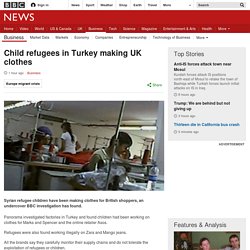
Panorama investigated factories in Turkey and found children had been working on clothes for Marks and Spencer and the online retailer Asos. Refugees were also found working illegally on Zara and Mango jeans. All the brands say they carefully monitor their supply chains and do not tolerate the exploitation of refugees or children. Sustainability. Wages are a very complex issue.

This is why we seek guidance from wage experts such as global trade unions, the ILO and the Fair Wage Network. They believe our role as a brand and buyer is not to set the level of wages. Rather, wages should be negotiated between the parties on the labour market. We share this view. It would be devastating if foreign companies such as H&M determined wage levels in any countries. We believe that everyone working in the textile industry, no matter what brand they are producing for, should earn a fair living wage. As collaboration is crucial, our strategy involves not only buyers such as H&M, but also suppliers, textile workers and national governments.
Fast Fashion Is the Second Dirtiest Industry in the World, Next to Big Oil - EcoWatch. “The clothing industry is the second largest polluter in the world ... second only to oil,” the recipient of an environmental award told a stunned Manhattan audience earlier this year.
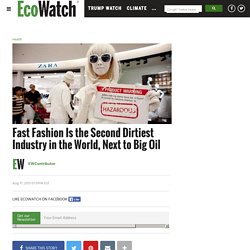
“It’s a really nasty business ... it’s a mess.” Since 2011, the Greenpeace Detox campaign has challenged some of the world's most popular clothing brands to eliminate all releases of hazardous chemicals. Photo credit: Jonas Gratzer / Greenpeace. FashRev Whitepaper Dec2015 screen. Fast fashion, "value" fashion. Fast fashion, "value" fashion ‘We now buy 40% of all our clothes at value retailers, with just 17% of our clothing budget.’

TNS Worldpanel (2006) Fashion Focus issue 29 A Cambridge University study reports that in 2006, people were buying a third more clothes than they were in 2002, and women have four times as many clothes in their wardrobe than they did in 1980. Women are also getting rid of similar amounts each year. Brands began competing against each other for market share by introducing more lines per year at lower costs, culminating in a situation where ‘fashion houses now offer up to 18 collections a year’ and the low cost, so called ‘value end’ is ‘booming; doubling in size in just 5 years Retailers must respond to quickly changing fashion trends, which now change in weeks instead of months – thanks in part to instant coverage of fashion weeks and street style online.
This naturally has led to pressure on the supply chain. A bit more context…. This had several benefits. H&M’s new kid’s collection has a cause. The list of species at risk is a long and depressing read: Tigers, snow leopards, pandas, finless porpoises, elephants and polar bears are just a few of the world’s threatened species.
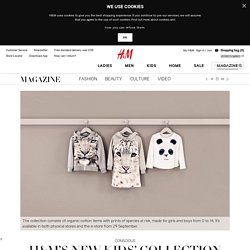
But when something is threatened, organizations, companies and individuals mobilize to make change happen. With H&M new kids’ collection, 10 percent of the sales revenue is donated to WWF’s work to conserve species at risk. Fashion sales wilt in September heatwave. Image copyright Getty Images Clothing retailers on the UK's High Streets suffered badly in the face of September's unseasonably hot weather, according to a new report Fashion sales fell in value by 5.9% compared with the same time last year, as shoppers shied away from buying autumn and winter stock.
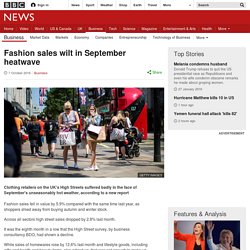
Across all sectors high street sales dropped by 2.8% last month. It was the eighth month in a row that the High Street survey, by business consultancy BDO, had shown a decline. While sales of homewares rose by 12.6% last month and lifestyle goods, including gifts and health and beauty items, also edged up, that was not enough to make up for the negative impact of the heatwave on fashion retailers. "September was always going to be tough when compared against a strong September 2015, but retailers should take the erratic weather as a lesson in the importance of flexibility," said BDO's head of retail, Sophie Michael.
Rio 2012: what can the fashion industry do to become more sustainable? Until the late 80s, fashion retailers and brands would typically have two main collections a year: spring/summer and autumn/winter.

Then, in the 90s things changed dramatically. Increased competition saw retailers incentivising customers to visit their stores more frequently. To do this they expanded their product ranges. The latest fashions seen on runways and celebrities began to rapidly populate high-street retailers' ranges. The Best Ethical Fashion Brands. What is ethical fashion?
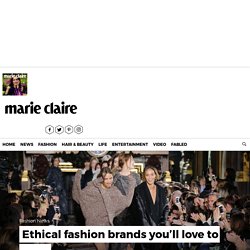
Green is the new black, people, because ethical fashion is higher than ever on the agenda for brands across the board from luxury, to high street – though shout out to Stella McCartney for pioneering the movement. Sustainability. Forbes Welcome. How can the fashion industry become more sustainable? The Centre for Sustainable Fashion provokes, challenges and questions the fashion status quo. Through collaboration we design transforming solutions that.